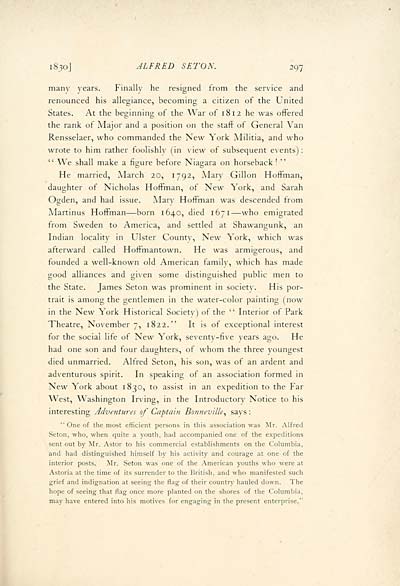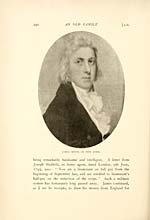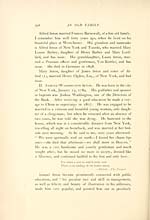Old family; or, The Setons of Scotland and America
(333) Page 297
Download files
Complete book:
Individual page:
Thumbnail gallery: Grid view | List view

1830] ALFRED SETOK. aq-]
many years. Finally he resigned from the service and
renounced his allegiance, becoming a citizen of the United
States. At the beginning of the War of 1812 he was offered
the rank of Major and a position on the staff of General Van
Rensselaer, who commanded the New York Militia, and who
wrote to him rather foolishly (in view of subsequent events):
' ' We shall make a figure before Niagara on horseback ! ' '
He married, March 20, 1792, Mary Gillon Hoffman,
daughter of Nicholas Hoffman, of New York, and Sarah
Ogden, and had issue. Mary Hoffman was descended from
Martinus Hoffman — born 1640, died 1671 — who emigrated
from Sweden to America, and settled at Shawangunk, an
Indian locality in Ulster County, New York, which was
afterward called Hoffmantown. He was armigerous, and
founded a well-known old American family, which has made
good alliances and given some distinguished public men to
the State. James Seton was prominent in society. His por-
trait is among the gentlemen in the water-color painting (now
in the New York Historical Society) of the " Interior of Park
Theatre, November 7, 1822." It is of exceptional interest
for the social life of New York, seventy-five years ago. He
had one son and four daughters, of whom the three youngest
died unmarried. Alfred Seton, his son, was of an ardent and
adventurous spirit. In speaking of an association formed in
New York about 1830, to assist in an expedition to the Far
West, Washington Irving, in the Introductory Notice to his
interesting Adventures of Captain Bonneville, says :
" One of the most efficient persons in this association was Mr. Alfred
Seton, who, when quite a youth, had accompanied one of the expeditions
sent out by Mr. Astor to his commercial establishments on the Columbia,
and had distinguished himself by his activity and courage at one of the
interior posts. Mr. Seton was one of the American youths who were at
Astoria at the time of its surrender to the British, and who manifested such
grief and indignation at seeing the flag of their country hauled down. The
hope of seeing that flag once more planted on the shores of the Columbia,
may have entered into his motives for engaging in the present enterprise."
many years. Finally he resigned from the service and
renounced his allegiance, becoming a citizen of the United
States. At the beginning of the War of 1812 he was offered
the rank of Major and a position on the staff of General Van
Rensselaer, who commanded the New York Militia, and who
wrote to him rather foolishly (in view of subsequent events):
' ' We shall make a figure before Niagara on horseback ! ' '
He married, March 20, 1792, Mary Gillon Hoffman,
daughter of Nicholas Hoffman, of New York, and Sarah
Ogden, and had issue. Mary Hoffman was descended from
Martinus Hoffman — born 1640, died 1671 — who emigrated
from Sweden to America, and settled at Shawangunk, an
Indian locality in Ulster County, New York, which was
afterward called Hoffmantown. He was armigerous, and
founded a well-known old American family, which has made
good alliances and given some distinguished public men to
the State. James Seton was prominent in society. His por-
trait is among the gentlemen in the water-color painting (now
in the New York Historical Society) of the " Interior of Park
Theatre, November 7, 1822." It is of exceptional interest
for the social life of New York, seventy-five years ago. He
had one son and four daughters, of whom the three youngest
died unmarried. Alfred Seton, his son, was of an ardent and
adventurous spirit. In speaking of an association formed in
New York about 1830, to assist in an expedition to the Far
West, Washington Irving, in the Introductory Notice to his
interesting Adventures of Captain Bonneville, says :
" One of the most efficient persons in this association was Mr. Alfred
Seton, who, when quite a youth, had accompanied one of the expeditions
sent out by Mr. Astor to his commercial establishments on the Columbia,
and had distinguished himself by his activity and courage at one of the
interior posts. Mr. Seton was one of the American youths who were at
Astoria at the time of its surrender to the British, and who manifested such
grief and indignation at seeing the flag of their country hauled down. The
hope of seeing that flag once more planted on the shores of the Columbia,
may have entered into his motives for engaging in the present enterprise."
Set display mode to:
![]() Universal Viewer |
Universal Viewer | ![]() Mirador |
Large image | Transcription
Mirador |
Large image | Transcription
Images and transcriptions on this page, including medium image downloads, may be used under the Creative Commons Attribution 4.0 International Licence unless otherwise stated. ![]()
| Histories of Scottish families > Old family; or, The Setons of Scotland and America > (333) Page 297 |
|---|
| Permanent URL | https://digital.nls.uk/95733915 |
|---|
| Description | A selection of almost 400 printed items relating to the history of Scottish families, mostly dating from the 19th and early 20th centuries. Includes memoirs, genealogies and clan histories, with a few produced by emigrant families. The earliest family history goes back to AD 916. |
|---|

